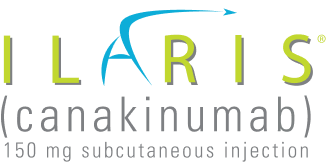![[Left] Man finding a lucky penny. [Right] Man contemplating the luck a penny could bring him.](https://usim.beprod.ilarishcp.com/sites/ilarishcp_com/files/styles/hero_full_width_width_2560/public/2024-08/mkd-hero-image-d.png?itok=5Ywu4cGD)
Cryopyrin-Associated Periodic Syndromes (CAPS)
Not an actual patient. Individual results will vary.
CAPS (including FCAS and MWS) is hereditary and can emerge from early childhood to adulthood1-6
| FCAS | MWS | |
| Attribute | Details | |
| Cutaneous findings |
| |
| Predominant ethnic distribution | Mostly European | |
| Worldwide prevalence or number of cases | <1 in 1 million* | |
| Typical age at onset | <1 year | <20 years |
| Duration of attacks | 12 to 24 hours | 2 to 3 days |
| Frequency of attacks | Variable; triggered by generalized cold exposure | Variable; triggered by cold, stress, and exercise |
| Gene mutation | NLRP3 | |
| Inheritance | Autosomal dominant | |
| Other select clinical features |
| |
| High serology | Increase in CRP, ESR, and SAA | |
Rash image credit: Reprinted from Textbook of Pediatric Rheumatology, 7th ed, Petty RE et al. Periodic Fever Syndromes and Other Inherited Autoinflammatory Diseases, page 617, 2016, with permission from Elsevier.
*Prevalence includes patients with FCAS, MWS, and NOMID.
References: 1. Yu JR, Leslie KS. Cryopyrin-associated periodic syndrome: an update on diagnosis and treatment response. Curr Allergy Asthma Rep. 2011;11(1):12-20. doi:10.1007/s11882-010-1060-9 2. Kastner DL. Hereditary periodic fever syndromes. Hematology Am Soc Hematol Educ Program. 2005;(1):74-81. doi:10.1182/asheducation-2005.1.74 3. Ciccarelli F, De Martinis M, Ginaldi L. An update on autoinflammatory diseases. Curr Med Chem. 2014;21(3):261-269. doi:10.2174/09298673113206660303 4. Hoffman HM, Simon A. Recurrent febrile syndromes—what a rheumatologist needs to know. Nat Rev Rheumatol. 2009;5(5):249-256. doi:10.1038/nrrheum.2009.40 5. Jesus AA, Oliveira JB, Hilário MO, et al. Pediatric hereditary autoinflammatory syndromes. J Pediatr (Rio J). 2010;86(5):353-366. doi:10.2223/JPED.2015 6. Barron KS, Kastner DL. Periodic fever syndromes and other inherited autoinflammatory diseases. In: Petty RE, Laxer RM, Lindsley CB, Wedderburn LR, eds. Textbook of Pediatric Rheumatology. 7th ed. Elsevier; 2016:609-626.
